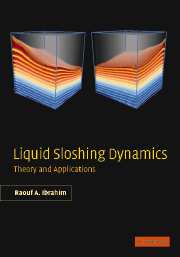Book contents
- Frontmatter
- Contents
- Foreword
- Acknowledgment
- Introduction
- Part I Linear sloshing dynamics
- 1 Fluid field equations and modal analysis in rigid containers
- 2 Linear forced sloshing
- 3 Viscous damping and sloshing suppression devices
- Part II Nonlinear and parametric sloshing dynamics
- Part III Sloshing – structure interaction
- Part IV Rotating fluid and low gravity sloshing
- References
- Index
1 - Fluid field equations and modal analysis in rigid containers
from Part I - Linear sloshing dynamics
Published online by Cambridge University Press: 11 August 2009
- Frontmatter
- Contents
- Foreword
- Acknowledgment
- Introduction
- Part I Linear sloshing dynamics
- 1 Fluid field equations and modal analysis in rigid containers
- 2 Linear forced sloshing
- 3 Viscous damping and sloshing suppression devices
- Part II Nonlinear and parametric sloshing dynamics
- Part III Sloshing – structure interaction
- Part IV Rotating fluid and low gravity sloshing
- References
- Index
Summary
Introduction
The theory of liquid sloshing dynamics in partially filled containers is based on developing the fluid field equations, estimating the fluid free-surface motion, and the resulting hydrodynamic forces and moments. Explicit solutions are possible only for a few special cases such as upright cylindrical and rectangular containers. The boundary value problem is usually solved for modal analysis and for the dynamic response characteristics to external excitations. The modal analysis of a liquid free-surface motion in a partially filled container estimates the natural frequencies and the corresponding mode shapes. The knowledge of the natural frequencies is essential in the design process of liquid tanks and in implementing active control systems in space vehicles. The natural frequencies of the free liquid surface appear in the combined boundary condition (kinematic and dynamic) rather than in the fluid continuity (Laplace's) equation.
For an open surface, which does not completely enclose the field, the boundary conditions usually specify the value of the field at every point on the boundary surface or the normal gradient to the container surface, or both. The boundary conditions may be classified into three classes (Morse and Fesbach, 1953):
the Dirichlet boundary conditions, which fix the value of the field on the surface;
the Neumann boundary conditions, which fix the value of the normal gradient on the surface; and
the Cauchy conditions, which fix both value of the field and normal gradient on the surface.
Each class is appropriate for different types of equations and different boundary surfaces.
Information
- Type
- Chapter
- Information
- Liquid Sloshing DynamicsTheory and Applications, pp. 3 - 87Publisher: Cambridge University PressPrint publication year: 2005
